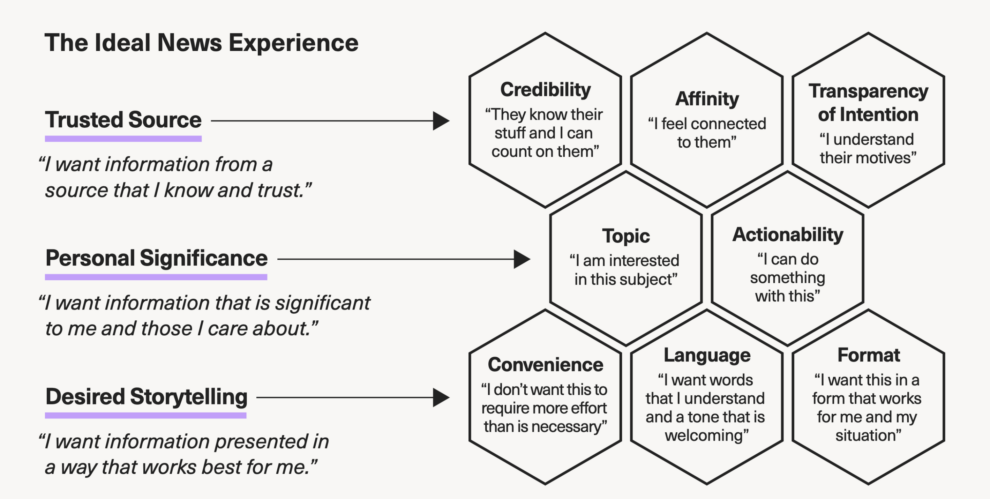Blog
Print is Dead. Long Live Digital (with some caveats).
Mélina Emdadi, Twipe’s Business Development Lead in North America, and Riccardo Fredro, Sales and Incubation Team Leader, recently completed a three-week US roadshow. The roadshow wrapped up with the Mather Symposium 2024 in Atlanta, Georgia. Here, Mélina shares her key insights from the event.
Mather Economics organizes the annual Mather Symposium, and this year, the focus was on optimizing revenue for media sustainability.
Print is dying.
This was the underlying story that shaped the presentations at the Mather Symposium. While print still provides the most revenue for publishers today, the consensus is that it will sharply decline.
So, the question emerges: What can publishers do to crack the code of sustainable digital revenue?
The answer was clear among every presenter at the Mather Symposium: We need to invest in digital products. Gert Ysebaert, Mediahuis CEO, predicts with his 7-7-7 framework that in 7 years, revenue from print will go down from 70% to 30%, with digital revenue growing to 70% in the same timeframe.
For every print subscription lost, publishers need to attract 2.5 digital subscribers to compensate.
Gert Ysebaert, Mediahuis CEO
As such, not only is there a need to transition print readers to digital, but also to increase the average revenue per user (ARPU) of digital subscribers. The solution to this dilemma is what each presenter ultimately tried to tackle throughout the symposium. Below, we share three strategies and insights on how publishers may do so.
1. Increase the digital subscriber base by targeting younger audiences.
Mediahuis found that the average age of a print reader is around 70 years old, whereas the average age of their digital news subscriber is 53. As such, with the decline of print, we can expect a rejuvenated reader demographic. Publishers should focus on growing their subscription numbers by appealing to a wider audience. In fact, it is a critical strategy for all publishers to target younger audiences, particularly Gen Z.
This said, targeting younger generations holds implications for the product itself. In the recent Gen Z Next Gen Report from FT Strategies and knight lab, one participant said he “would rather watch a video for three minutes than read an article for a minute”—a preference that speaks volumes about this audience’s engagement style. With young readers turning to platforms like Instagram, TikTok or YouTube for news discovery, publishers must make their digital offering more engaging and interactive to be attractive to this audience (as well as being in these spaces).
Targeting Gen Z also holds implications for the content of publications itself, but we explore this in the following point.
2. News organizations need to show what value they bring more prominently.
Trust is at the heart of journalism. As Gert Ysebaert, Mediahuis CEO, stated, “Trust is the difference between professional journalism and social media.”
To be the trusted source of information is an asset worth paying for, particularly in a world where misinformation runs rampant, and there is a constant flow of low-value content.
Trust is one of the key factors for Gen Z’s ideal news experience framework, together with personalization and effective storytelling. In the Next Gen News Report, interviewees stated that:
- “I want information from a source that I know and trust.”
- “I want information that is significant to me and those I care about.”
- “I want information presented in a way that works best for me.”
This is particularly true for younger audiences who are more likely to search for solutions-based journalism, according to Liesbeth Nizet (Managing Director at Mather Economics Europe). Solutions-based journalism is a method that emphasizes reporting on solutions to problems, focusing on positive outcomes and ways to address challenges. This approach particularly appeals to younger audiences. It offers an antidote to the negativity and sensationalism prevalent in today’s news, resonating with individuals seeking impactful stories of positive change.

3. Everyone has a price. But not everyone’s price is the same.
To counter the decline in print, newspapers must focus on increasing the average revenue per user (ARPU) of digital subscriptions.
However, effective monetization hinges on smart segmentation; not every reader has the same needs or value perception. Tailored pricing strategies, informed by data, can significantly curb churn. For instance, Kelli Dakake, Hearst’s Engagement and Retention Vice-President, brought forward Hearst’s experiment with pricing models, where they leveraged data analytics to assess digital subscriber loyalty risk through their Subscriber Score strategy.
Another innovative approach was brought forward by Debbie Tolman, Director of Advance Local’s Digital Consumer Revenue: They offered a free 7-day trial paired with personalized follow-ups, which led to an impressive 18-fold rise in subscription conversions.
Subscribers with higher monthly prices exhibit lower pricing sensitivity, indicating the potential for dynamic pricing strategies tailored to individual characteristics. There’s room to explore and optimize, with no definitive ceiling on the potential for subscriptions, as Greg Piechota said during INMA’s Media Subscriptions Summit.
Investing in the future: from print profits to digital dominance
The insights from the Mather Symposium highlight a pivotal moment for the media industry as the shift from print to digital becomes increasingly urgent. Gert Ysebaert’s discussion, especially the 7-7-7 strategy, points to a clear need for media outlets to adapt to digital realities, focusing on sustainability and innovation. At this critical juncture, publishers should take the profits they still make from print and invest them back into their digital products and newsrooms.
Other Blog Posts

Stay on top of the game
Subscribe to Twipe’s weekly newsletter to receive industry insights, case studies, and event invitations.
"(Required)" indicates required fields

